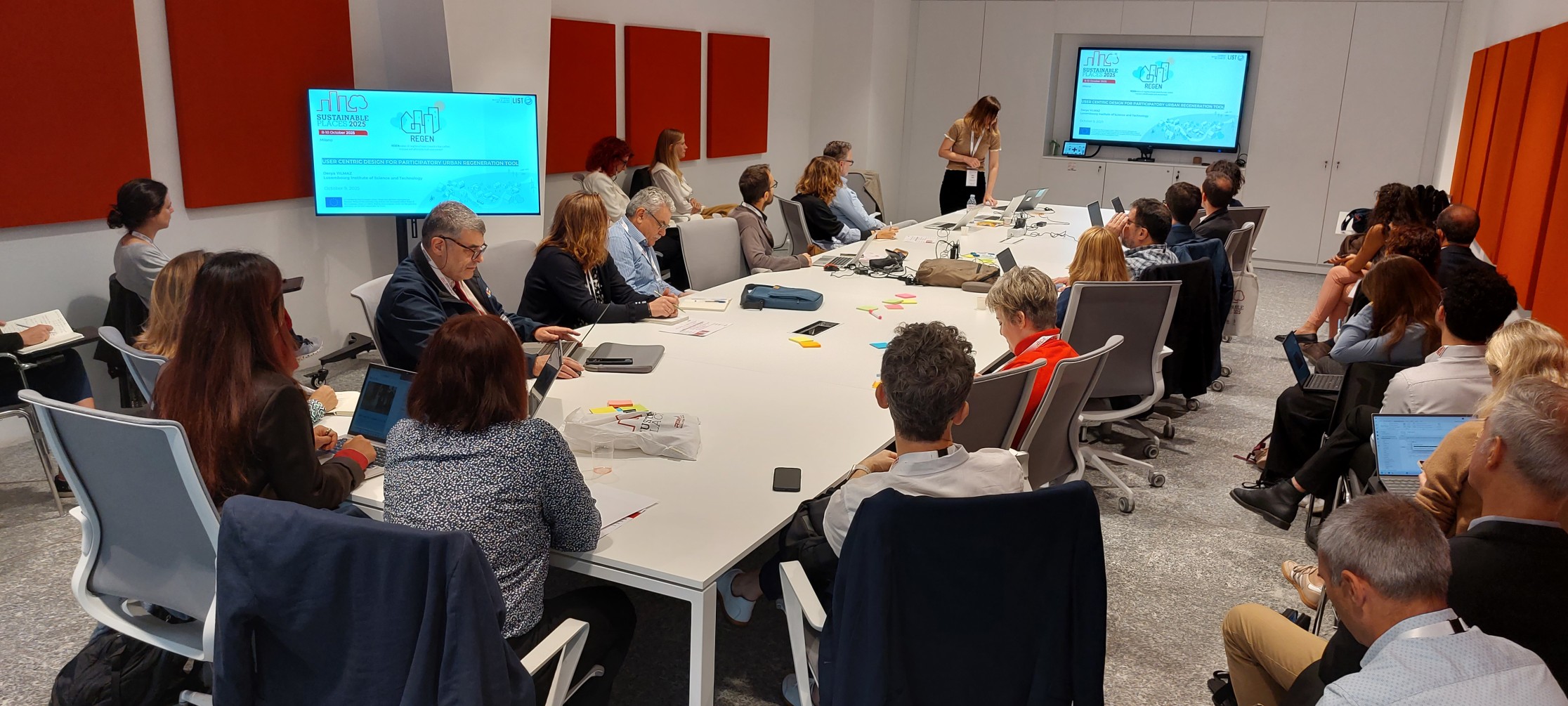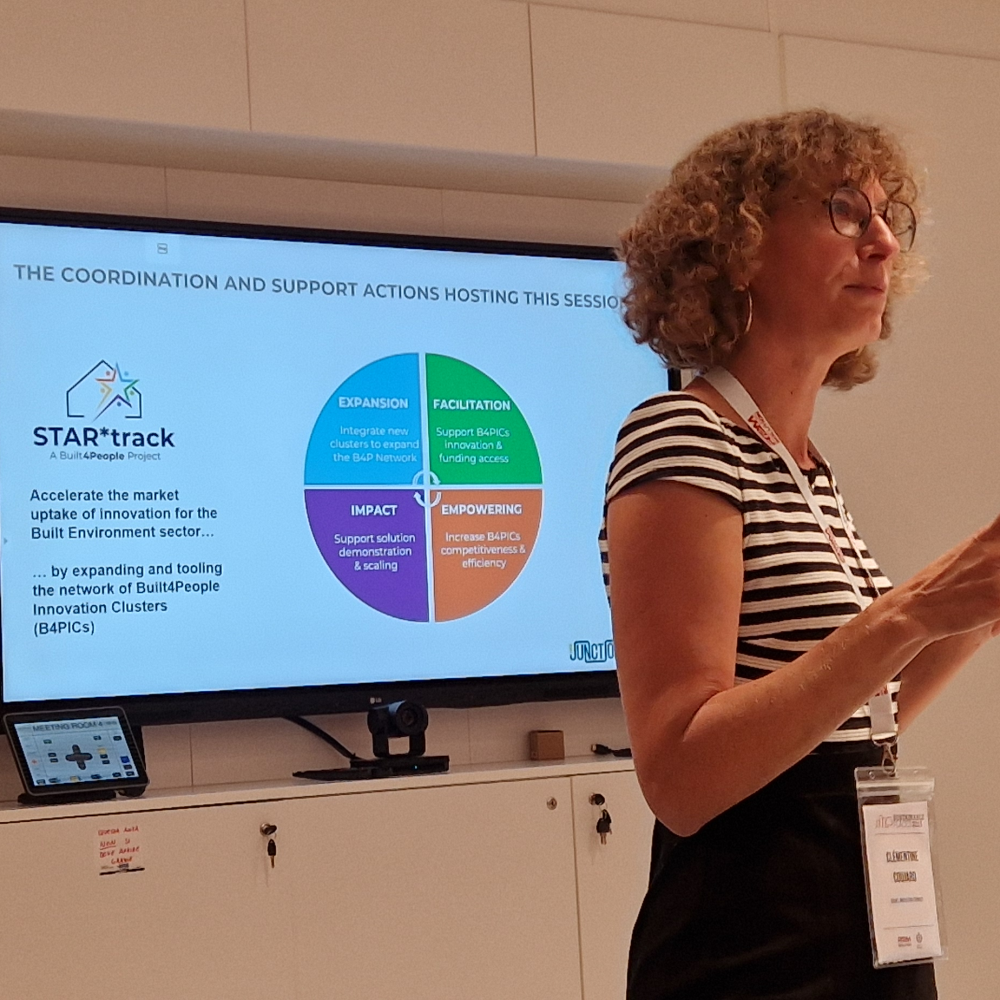
How do we turn sustainability, beauty, and inclusion — the three pillars of the New European Bauhaus (NEB) — into something concrete?
This was the central question of the interactive workshop organised by Star Track and NEB Junction Coordination and Support Actions, gathering more than 20 EU-funded projects working across design, construction, materials, and community engagement for the built environment.
A movement gaining momentum
In less than five years, the New European Bauhaus has become a rallying point for researchers, designers, and innovators rethinking our living spaces. By bridging art, sciences, and engineering, the NEB calls for a transformation that is not only technological but also cultural and human-centred.
The workshop explored how this vision translates into research and innovation practice, with concrete tools and methods from ongoing projects: participatory design, co-creation, reuse of materials, and digital tools for citizen engagement. The workshop showcased tools and methods that make this vision tangible:
- Participatory design for neighbourhood regeneration (REGEN)
- Co-creation for social housing renovation (drOp)
- Sustainable materials and skills development (INGUMA, WoodStock, NEB Academy)
- Urban mining for façade reuse (AEGIR)
- Strategy games to design decarbonisation pathways (TIMEBERHAUS)
- Digital tools for energy communities (GINNGER)
- Visualisation for indoor air quality awareness (IAQ Society)
Different topics, same ambition: to combine technology, creativity, and community.

Expectation Management in Stakeholder Engagement
Participants underlined a recurring challenge: public authorities can show reluctance to engage citizens in the framework of R&D projects, fearing that such activities might raise unrealistic expectations.
- Silvia Urra (TECNALIA) stressed the importance of transparency: partners should clearly explain what the R&D project activities will and will not cover to avoid disappointment.
- Chiara Fonio (ICONS) added that expectation management is a key element of any stakeholder engagement process. Setting clear boundaries from the start ensures more constructive participation and sustainable relationships with citizens.
Achieving Inclusiveness with vulnerable populations
Inclusiveness remains one of the most challenging NEB values to implement in real-life project activities.
- Chiara Fonio (ICONS) pointed out that reaching vulnerable populations — particularly children and the elderly — requires tailored approaches.
- Clémentine Coujard (DOWEL) emphasised that engagement activities in local demonstration sites must rely on local facilitators who master both the language and context.
- Florence Kuijl (InnovaWood) highlighted the value of Living Labs as effective frameworks for building trust and local ownership.
Several projects are addressing the difficulty of engaging groups with low digital literacy or limited participation capacity:
- Participants described efforts to develop digital participation tools, while recognising the gap between such tools and the needs, interests and capacities of audiences such as elderly or kids.
- Derya Yilmaz (LIST) shared the use of personas, a design thinking tool, to better consider the citizens’ perspectives. She also described the tangible table, an interactive tool facilitated by a moderator, which they use in their R&D project, to foster interactions with senior participants. While these tools attract interest, they often require expert facilitation to foster genuine feedback.
- Chiara Fonio (ICONS) recommended systematically assessing the levels of digital literacy of the targeted stakeholders, right from the project proposal stage, to ensure that participatory tools are accessible and processes adapted from the outset.
- Artistic interventions can act as a bridge between communities and innovation projects. Combining physical spaces with artistic performances better enables to reach children and vulnerable people. These artistic activities serve as an entry point for engagement, allowing emotional connection before introducing digital or technical participation tools.
Children and young people can play an active role in co-designing future living environments, if appropriate participatory tools are used. Alexander Deliyannis (SYMPRAXIS) mentioned a project in which children used the very popular video game Minecraft, which they master very well, to visualise and express ideas for their neighbourhoods. One creative engagement exercise asked: “What would it take for you to put your phone down and go outside?” — prompting children to reimagine playgrounds and public spaces from their own viewpoint.
Understanding and Integrating “Beauty”
The concept of “beauty” within the NEB remains complex and multidimensional.
- Silvia Urra (TECNALIA) noted that beauty is often misunderstood and should encompass a sense of belonging, identity, and history.
- Sylvain Kubicki (LIST) highlighted the need to move from quantitative indicators to qualitative, social-science-driven assessments to capture what makes an experience beautiful and enriching.
- Participants agreed that balancing efficiency and beauty remains a delicate exercise in technical projects.
Conclusion and next steps
As a conclusion, participants drawn some recommendations in the form of “does and don’ts” for future NEB Projects:
Do’s
- Treat residents as co-creators, not beneficiaries.
- Involve children and schools early in the process
- Ensure communication partners are strong and creative — communication means awareness.
- Encourage manufacturing companies and technicians to integrate NEB values into daily practice.
Don’ts
- Do not underestimate the role of beauty and identity in social acceptance
- Do not separate environmental performance from social inclusion
- Do not overlook people outside the project who may influence or be affected by its outcomes.
The insights from this workshop will contribute to the ongoing work of the Star Track and NEB Junction projects, notably towards:
- the creation of the NEB Hub for results and impact, and
- the support of local innovation ecosystems integrating NEB principles into their transformation processes.
Clémentine Coujard
Senior Consultant, DOWEL Innovation
Credits:
We thank Silvia Urra Uriarte (TECNALIA), Florence Kuijl (INNOVAWOOD), Chiara Fonio (ICONS), Derya Yilmaz (LIST), Mikael Borjesson (Indoor Air Quality Society) for contributing to the preparation and implementation of this workshop.
We also thank all attendees for their active participation, with special mention to the following projects: SNUG, INBUILT Project, REN+HOMES, SIRCULAR Project, LEGOFIT, INPERSO Project, RECONMATIC, GreeNest project, COLLECTiEF project, H2020 INFINIT, Caleche LIFE23-CET-BARRIO, Metabuilding Labs.


